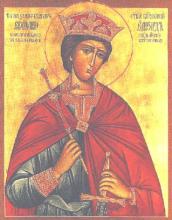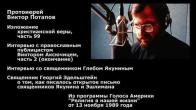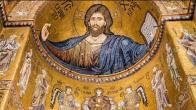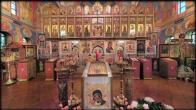You are here
Holy Martyr King Edward of England
18/31 March
 Edward was the oldest son of English King Edgar, who reigned from the year 957. Edgar, like his famous great-grandfather King Alfred the Great, was remembered as a monarch who served God and his people with faith and justice. During his reign, England not only achieved stability among the other realms of Europe, but experienced a time of real prosperity. The land became ever more united as one people, and with a king like Edgar, the people looked forward confidently to its future. European chroniclers of the time were unanimous in recognizing England to be a land in the full bloom of culture nurtured by Christianity. We might add that this Christianity was Orthodox and continued to be so until the Norman invasion, which brought to the land a new foreign government and to the English Church a crushing blow, conceived and executed with the blessings of proud and intolerant Rome.
Edward was the oldest son of English King Edgar, who reigned from the year 957. Edgar, like his famous great-grandfather King Alfred the Great, was remembered as a monarch who served God and his people with faith and justice. During his reign, England not only achieved stability among the other realms of Europe, but experienced a time of real prosperity. The land became ever more united as one people, and with a king like Edgar, the people looked forward confidently to its future. European chroniclers of the time were unanimous in recognizing England to be a land in the full bloom of culture nurtured by Christianity. We might add that this Christianity was Orthodox and continued to be so until the Norman invasion, which brought to the land a new foreign government and to the English Church a crushing blow, conceived and executed with the blessings of proud and intolerant Rome.
Edwards’s mother died early, and his king and father married Elfrida (Aelfthryth), a widow of some importance, who bore Edgar another son, Ethelred (Aethelred). Edward’s half-brother was five years younger than he. According to the country’s laws, the legitimate heir to the throne was the king’s eldest son, in this case, Edward. However, his stepmother conceived a truly diabolical plan to make her son Ethelred the next king of England at any price.
It is important to note that during Edgar’s reign, church reforms intended to bolster monasticism were initiated. The proposed reform contemplated that English monasteries institute the Rule of Venerable St. Benedict of Nursia, a famous Orthodox organizer of communal monastic life, who brought to the West the traditions of Eastern Orthodox monasticism, with which he was quite familiar. His name was later taken by one of the West’s greatest monastic orders, the Benedictines. The spiritual leader and principal promoter of those reforms in England was St. Dunstan, Archbishop of Canterbury, who had been the prior of the famous monastery of Glastonbury. The people considered St. Dunstan a person of unusually great authority. He composed and performed the rite of coronation over Edgar, who then appointed Dunstan to be his closest advisor.
King Edgar, known as the Peacemaker, successfully ruled England for eighteen years before departing to the Lord in 975. After his death, his eldest son Edward ascended to the English throne. At the time, the boy-king was no more than 12 years of age, but he immediately showed himself to be worthy of continuing his father’s work. Beneficial church reforms, led as before by St. Dunstan, continued apace under the new king.
However, not everyone in England regarded the changes in the Church, and especially their support by young King Edward, with a pure heart and without dark thoughts. Many of the important and wealthy political leaders regarded the Church as a means of dishonestly enriching themselves and of gaining various types of political opportunities. They formed something of a party in opposition to the reforms. Its formal head was Elver, Count of Mercia, but its soul was Edward’s stepmother, the widowed Queen Elfrida. Supporters of King Edward and Holy Hierarch St. Dunstan were St. Oswald, Archbishop of York, and Lord Brihtnoth, a person of influence in the kingdom.
Edward’s opponents held so much hatred for him that they decided to hurry to achieve what they desired. These people preferred operating more in the dark than in the light, which explains why the young king trusted them and with a light heart accepted his stepmother’s invitation to visit, with only a small retinue, at Corfe Castle, Dorchester, where Elfrida and her son Ethelred lived. On March 18, 979, Edward arrived at the place of his downfall.
He rode on horseback into the castle courtyard and was met with gestures of welcome by Elfrida’s people. Suddenly they seized their king by the arms, and one of the servants stabbed Edward in the chest with a dagger. The blow apparently was so powerful that the young king fell from his saddle. One of his legs was caught in the stirrup, and as his terrified mount horse burst through the castle gate and ran toward the woods, it dragged the body of the mortally wounded Edward along the ground. When the king’s entourage finally managed to bring the horse to a halt, they saw that young King Edward was dead.
At Elfrida’s order, his body was quickly buried without due ceremony at the little church in Wareham, several miles from Corfe Castle, the site of the perfidious act. In but a short time, another boy, 11 year-old Ethelred, was declared king of England.
No one in England doubted that King Edward had been murdered at the order of those whose identities everyone knew. However, the voice of St. Dunstan, the king’s faithful friend, was stifled, and unfortunately all England remained silent. No one was called to account before a court for the treasonous murder. The only thing St. Dunstan could do for his king he did in 981, when he managed to bring his precious remains to the Shaftesbury Monastery, founded by Edward’s great-great-grandfather, England’s King Alfred the Great. Two years had passed since the murder, but the procession taking Edward to his new place of burial was greater than any England had ever witnessed.
God’s judgment is unlike that of human courts. Betrayed by his servants on earth, the young King Edward, with his love for God’s Church and with his own blood, found good will in the Lord’s eyes. As tradition tells us, miracles at his grave began to happen the night after his cruel murder. An old blind woman, in whose poor hut Edward’s body awaited burial, suddenly gained her sight! Soon, a healing spring burst forth near the Royal Martyr’s first grave. It became a site of pilgrimage. When Edward’s body was transferred to Shaftsbury, he began to be universally venerated. The veneration was so extensive that twenty years later, in 1001, King Ethelred ordered that a new and rich reliquary be prepared for his brother’s honorable relics. Pilgrims would even come from the continent to venerate the Passion-bearer. Seven years later Alphege, the new Archbishop of Canterbury and future hieromartyr, speaking for the Anglican Church, officially declared Edward a saint. In time, the monastery where his holy relics reposed became known as St. Edward’s Abbey, and remained in existence until the beginning of the Reformation in England in the 16th century. Over the course of several centuries, the Saint was revered by many Christian peoples.
We remember that Ethelred became king at the age of only 11, and can suppose that this happened only thanks to his mother’s desires and machinations. Ethelred is recorded in history as Ethelred the Unready. Thus did the people respond to his not too successful rule, which constantly brought his land into bloody wars with the invading Danes. It is significant that this king, who was a usurper – albeit an involuntary one – had around him no wise councilors to whom he could turn for advice and support. The days of the old, glorious England were almost over and perhaps the murder of King Edward provided the mystical jolt that fundamentally changed the fate of that land. One must admit that, to Ethelred’s credit, all his life he venerated King Edward as a saint. The chroniclers recorded the actual words Ethelred spoke over the holy relics of his brother and predecessor: “It pleased the Lord to glorify him in our days, manifesting a multitude of signs and wonders after his blood was shed.”
Ethelred ruled over England for a long time – for an entire 38 years – and died in 1016. He named his first-born son Edward.
St. Dunstan took no part in King Ethelred’s affairs, but continued his ascetic labors for the good of the Church. He reached the end of his earthly path in 988, when at the other end of Europe, the lamp of Orthodoxy was being lit for Rus’.
We have yet to mention the fate of the cause of the Royal Martyr’s death, his stepmother Elfrida. By the prayers of St. Edward, God did not cast her aside. Elfrida sincerely repented of her evil acts. Using her own funds to establish two convents, the former queen left the stormy world and settled down as a simple nun in one of them; there she died in 999.
Orthodoxy, which is universal, is bound neither by time nor distance, and the Saints of ancient Orthodox Britain, Ireland and Gaul are our Saints as well, Saints who are ready to help us today if our soul should respond with memory, love, and prayer, to the podvig of their lives, which they gave over to Christ.
In conclusion, a few words about the fate of King Edward’s holy relics. For a long time, they were thought to have been lost. However, quite recently, in the 1930s, an English amateur archaeologist found them. It was later convincingly established that these were the actual relics of the Saint.
What for us Orthodox is the greatest cause for joy is that he decided to give this great holy treasure to one of the
English parishes of the Russian Orthodox Church Outside of Russia – the Church of St. Edward in Brookwood, in the County of Surrey.
Holy Martyr King Edward is commemorated on March 31 (civil calendar), the day after the commemoration of St. Patrick, Enlightener of Ireland.
Relics in cathedral - monthly calendar
| S | M | T | W | T | F | S |
|---|---|---|---|---|---|---|
|
|
|
|
1
|
2
|
3
|
4
|
|
5
|
6
|
7
|
8
|
9
|
10
|
11
|
|
12
|
13
|
14
|
15
|
16
|
17
|
18
|
|
19
|
20
|
21
|
22
|
23
|
24
|
25
|
|
26
|
27
|
28
|
29
|
30
|
31
|
|
PARISH LIFE
Address of our Cathedral
While all the materials on this site are copyrighted, you may use them freely as long as you treat them
with respect and provide attribution on the Russian Orthodox Cathedral of St.John the Baptist of Washington DC.









